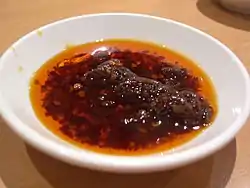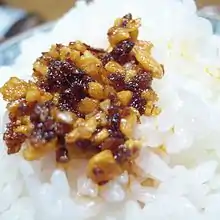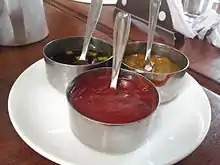Chili oil
Chili oil is a condiment made from vegetable oil that has been infused with chili peppers. Different types of oil and hot peppers are used, and other components may also be included. It is commonly used in Chinese cuisine, East and Southeast Asia and elsewhere. Particularly popular in Sichuan cuisine, Hunan cuisine, and Shaanxi cuisine it is used as an ingredient in cooked dishes as well as a condiment. It is sometimes used as a dip for meat and dim sum. It is also employed in the Korean Chinese noodle soup dish jjamppong.
 | |
| Alternative names | Hot chili oil, hot oil |
|---|---|
| Type | Dip |
| Main ingredients | Vegetable oil, chili peppers |
| Chili oil | |||||||
|---|---|---|---|---|---|---|---|
| Chinese name | |||||||
| Traditional Chinese | 辣油, 紅椒油, 紅油, 辣椒油, 紅辣椒油, 油泼辣子 | ||||||
| Simplified Chinese | 辣油, 红椒油, 红油, 辣椒油, 红辣椒油, 油潑辣子 | ||||||
| |||||||
| Vietnamese name | |||||||
| Vietnamese | ớt sa tế, ớt satế | ||||||
| Thai name | |||||||
| Thai | น้ำมันพริก | ||||||
| RTGS | nam man phrik | ||||||
| Korean name | |||||||
| Hangul | 고추기름 | ||||||
| |||||||
| Japanese name | |||||||
| Kanji | ラー油, 辣油 | ||||||
| |||||||
Chili oil is typically red in color. It is made from vegetable oil, often soybean oil or sesame oil, although olive oil or other oils may be used. Other spices may be included such as Sichuan pepper, garlic, or paprika. Commercial preparations may include other kinds of oil, water, dried garlic, soy sauce, and sugar. Recipes targeted to Western cooks also suggest other popular oils such as rapeseed, grapeseed or peanut, and any dried or fresh chili peppers. The solids typically settle to the bottom of the container in which it is stored. When using chili oil, the cook or diner may choose how much of the solids to use; sometimes only the oil is used, without any solids.
Chili oil is easy to prepare, and is also commercially available in glass jars or bottles.[1]
Varieties and regional use
China
Chili oil has various names in China. It is called yóu pō là zǐ (油泼辣子, chili pepper splashed with oil) in Shaanxi province and là yóu (辣油, spicy oil) or hóng yóu (紅油, red oil) in Sichuan province. Among those names the most popular one is là jiāo yóu (辣椒油, chili pepper oil).
In China, chili oil is prepared basically by pouring hot vegetable oil slowly on chili pepper powder or chopped chili pepper.[2] Many other ingredients can be added alongside to enrich flavor such as Chinese black vinegar, minced garlic, dried ginger skin, sesame seeds, sesame oil, Sichuan peppercorn, cinnamon, star anise and bay leaf. There are also many condiments derived from chili oil, such as Lao Gan Ma, made with chili oil and Douchi (豆豉, fermented black soybeans).
Chili oil can be consumed directly with other food. It is used extensively in cooking all over China especially in Shaanxi, Sichuan, and Hunan cuisine. Like Hóngyóu chāoshǒu (紅油抄手, wonton in red oil) and Dàn dàn Noodles (擔擔麵).
Japan

The Japanese variety of Chinese chili oil is known as rāyu (ラー油 or 辣油), used in Japan as a cooking ingredient or as a condiment. It is typically a clear, chili-infused sesame oil, and the chopped chili pepper used is typically red, imparting a reddish tint to the oil.[3] Other ingredients used may include soy oil, corn oil, dried aloe, ginger, guava leaves, leek leaves, paprika, and turmeric.
A new type of product known as taberu rāyu (食べるラー油 or -辣油, literally, "rāyu for eating") was introduced in 2009.[4][5] It is less spicy-hot, and includes chunks of food such as fried garlic and fried onion in the oil.[6]
Italy
The Italian variety of chili oil (olio di peperoncino) originates from the southern region of Calabria. This variety of chili oil uses olive oil as a base, and has a unique brine flavor. The Peperoncino is a popular food item in Calabria.
Portugal
Portuguese chili oil is made by cold (refrigerated) infusion of dried red chili peppers in olive oil in a tightly capped bottle for one month.[7]
Turkey

Chili and pepper infused oils are used widely as a condiment in Turkish cuisine. Turkish dumpling mantı is served with chili infused oil poured over the garlic yoghurt sauce.[8] The oil is prepared with mixing chili paste (Turkish: biber salçası) and certain spices and herbs such as black pepper, chili flakes or powder, dried mint and cumin.
Strained yoghurt is also topped with sizzling oil infused with dried hot chili peppers. This dish is called atom in Turkish and typically served as a meze.[9][10]
References
- Flickr. making chili oil, step 1
- 油潑辣子
- "Spicing Up the Menu With Rayu". Archived from the original on 2015-05-18. Retrieved 2015-05-07.
- Google Trends: 食べるラー油
- "Taberu Rayu".
- "Recipe for home-made Taberu-Rayu".
- Irma S. Rombauer; Marion Rombauer Becker; Ethan Becker; Maria Guarnaschelli (5 November 1997). JOC All New Rev. 1997. Simon and Schuster. p. 78. ISBN 978-0-684-81870-2.
- Dubin, Marc (2002). Cyprus. Rough Guides. ISBN 978-1-85828-863-5.
- Guides, Fodor's Travel (2019-06-18). Fodor's Essential Turkey. Fodor's Travel. ISBN 978-1-64097-141-7.
- Özcan, Şükran (2019-09-23). Meze: Lezzetli, Çeşitli ve Görkemli (in Turkish). Yeşim Özcan.

